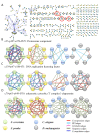Biological interaction networks are conserved at the module level
- PMID: 21861884
- PMCID: PMC3212960
- DOI: 10.1186/1752-0509-5-134
Biological interaction networks are conserved at the module level
Abstract
Background: Orthologous genes are highly conserved between closely related species and biological systems often utilize the same genes across different organisms. However, while sequence similarity often implies functional similarity, interaction data is not well conserved even for proteins with high sequence similarity. Several recent studies comparing high throughput data including expression, protein-protein, protein-DNA, and genetic interactions between close species show conservation at a much lower rate than expected.
Results: In this work we collected comprehensive high-throughput interaction datasets for four model organisms (S. cerevisiae, S. pombe, C. elegans, and D. melanogaster) and carried out systematic analyses in order to explain the apparent lower conservation of interaction data when compared to the conservation of sequence data. We first showed that several previously proposed hypotheses only provide a limited explanation for such lower conservation rates. We combined all interaction evidences into an integrated network for each species and identified functional modules from these integrated networks. We then demonstrate that interactions that are part of functional modules are conserved at much higher rates than previous reports in the literature, while interactions that connect between distinct functional modules are conserved at lower rates.
Conclusions: We show that conservation is maintained between species, but mainly at the module level. Our results indicate that interactions within modules are much more likely to be conserved than interactions between proteins in different modules. This provides a network based explanation to the observed conservation rates that can also help explain why so many biological processes are well conserved despite the lower levels of conservation for the interactions of proteins participating in these processes.Accompanying website: http://www.sb.cs.cmu.edu/CrossSP.
Figures





Similar articles
-
Genetic interaction networks: better understand to better predict.Front Genet. 2013 Dec 17;4:290. doi: 10.3389/fgene.2013.00290. Front Genet. 2013. PMID: 24381582 Free PMC article. Review.
-
An integrative approach to inferring biologically meaningful gene modules.BMC Syst Biol. 2011 Jul 26;5:117. doi: 10.1186/1752-0509-5-117. BMC Syst Biol. 2011. PMID: 21791051 Free PMC article.
-
Protein-protein interactions more conserved within species than across species.PLoS Comput Biol. 2006 Jul 21;2(7):e79. doi: 10.1371/journal.pcbi.0020079. Epub 2006 May 18. PLoS Comput Biol. 2006. PMID: 16854211 Free PMC article.
-
Identifying conserved protein complexes between species by constructing interolog networks.BMC Bioinformatics. 2013;14 Suppl 16(Suppl 16):S8. doi: 10.1186/1471-2105-14-S16-S8. Epub 2013 Oct 22. BMC Bioinformatics. 2013. PMID: 24564762 Free PMC article.
-
PainNetworks: a web-based resource for the visualisation of pain-related genes in the context of their network associations.Pain. 2013 Dec;154(12):2586e1-2586e12. doi: 10.1016/j.pain.2013.09.003. Epub 2013 Sep 11. Pain. 2013. PMID: 24036287 Free PMC article. Review.
Cited by
-
The evolutionary dynamics of protein-protein interaction networks inferred from the reconstruction of ancient networks.PLoS One. 2013;8(3):e58134. doi: 10.1371/journal.pone.0058134. Epub 2013 Mar 20. PLoS One. 2013. PMID: 23526967 Free PMC article.
-
Integrating data and knowledge to identify functional modules of genes: a multilayer approach.BMC Bioinformatics. 2019 May 2;20(1):225. doi: 10.1186/s12859-019-2800-y. BMC Bioinformatics. 2019. PMID: 31046665 Free PMC article.
-
Biophysical constraints on the evolution of tissue structure and function.J Physiol. 2014 Jun 1;592(11):2389-401. doi: 10.1113/jphysiol.2014.273235. J Physiol. 2014. PMID: 24882821 Free PMC article.
-
Genetic interaction networks: better understand to better predict.Front Genet. 2013 Dec 17;4:290. doi: 10.3389/fgene.2013.00290. Front Genet. 2013. PMID: 24381582 Free PMC article. Review.
-
Optimization criteria and biological process enrichment in homologous multiprotein modules.Proc Natl Acad Sci U S A. 2013 Jun 25;110(26):10872-7. doi: 10.1073/pnas.1308621110. Epub 2013 Jun 11. Proc Natl Acad Sci U S A. 2013. PMID: 23757502 Free PMC article.
References
Publication types
MeSH terms
Substances
Grants and funding
LinkOut - more resources
Full Text Sources
Other Literature Sources
Molecular Biology Databases

